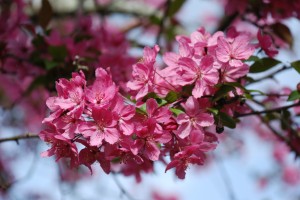Crabapples (Malus spp.) get a bad rap! Many gardeners associated them with the old diseased and pest prone varieties planted a half-century ago. Modern cultivars make nice small ornamental trees. The new cultivars exhibit exceptional resistance to five serious diseases of crabapples: apple scab, fire blight, cedar-apple rust, leaf spot and powdery mildew. Three of the best cultivars include ‘Prairifire’, Sugar Tyme™ (Malus ‘Sutyzam’), and ‘Louisa’ (Malus ‘Louisa’) crabapples.
Sugar Tyme crabapple has moderate upright branching and forms an oval tree top or canopy. It matures to 20 by 15 feet in height and spread. Pink in bud, flowers open snowy white. The mostly blemish-free dark green summer leaves turn a bronzy to yellow in mid-autumn. The ½-inch diameter ruby red fruit ripen in fall and persist through winter.
Prairifire (listed also as “Prairie Fire”) forms a densely round deciduous tree, 15 by 20 feet in height and spread at maturity. Pinkish-red buds open to lightly fragrant red flowers. A good annual crop of small ½ -inch diameter purplish-red fruits ripen in the fall and persist through the winter.
Louisa is a weeping, pink-flowered crabapple tree that typically matures 15 to 18 feet high and wide. The cascading branches may be lopped off anytime they touch the ground. Reddish floral buds open to fragrant light pink blossoms. Tiny 3/8-inch diameter fruits mature to yellow with a pale rosy blush and persist well into winter.
Crabapples grow in compost-rich, well-drained acidic soil, and in full sun. Prune the tree(s), as needed, after flowering before the end of May (USDA Zones 4–8). All three cultivars produce no messy fruits, most of which are consumed by hungry winter-feeding birds. If you’re tired of the Bradford pear look, plant a crabapple.


 Posted in
Posted in 
